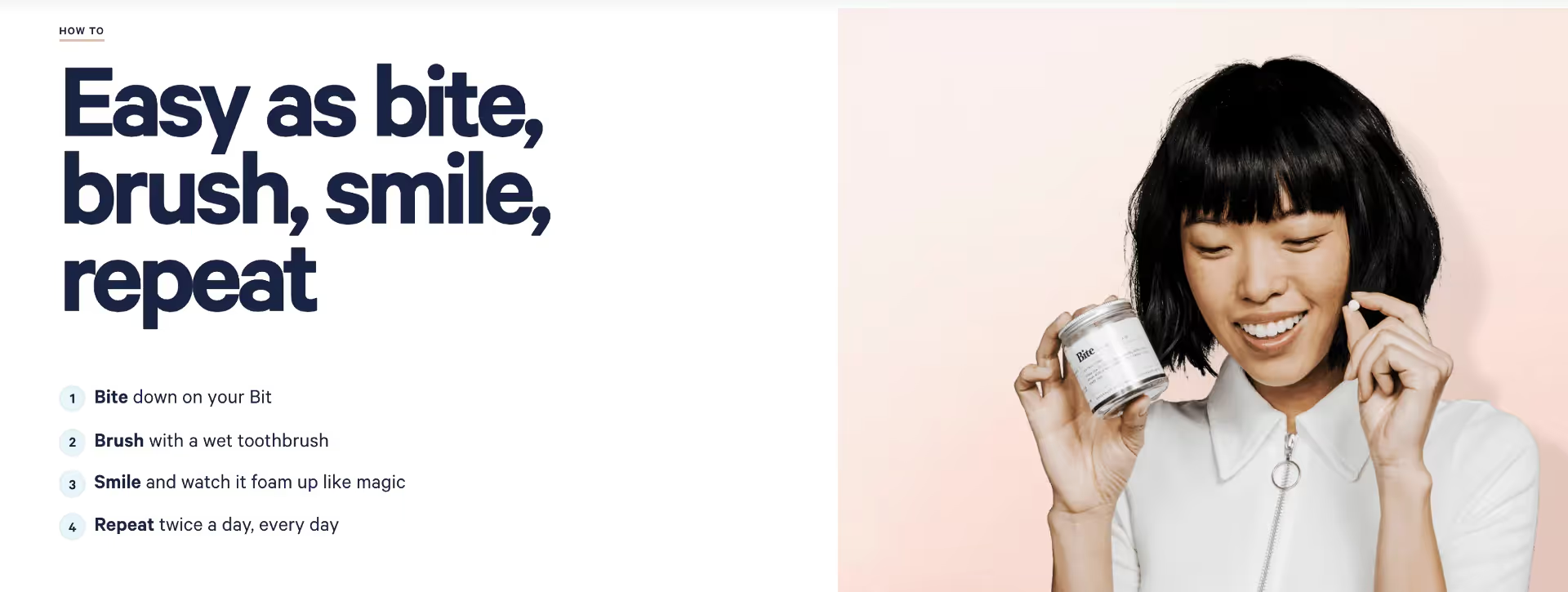Have you heard of Bite Toothpaste? Bite is an all-natural, plastic-free, refillable alternative to standard toothpaste. Instead of a paste, you bite down on the pill-sized tablet, wet your toothbrush, and scrub away. Bite’s Founder, Lindsay McCormick, didn’t initially set out to start a company — she wanted to solve a problem. According to her video, “How We Got Here,” Lindsay recognized that whenever she would travel for work, she would go through travel-sized toothpaste tubes at an alarming rate, creating completely unnecessary waste that would eventually end up in landfills and the ocean.
Bite’s instructions are simple: bite. brush. smile. repeat. zero paste. zero waste.
Don't start with features when developing a product
When developing a product, we often start with features. What does the product actually do? How does it do it? How does this new product outperform the competition? The truth is, that sometimes features aren’t where innovation lives. Sometimes, innovation is all in the packaging.
Consider the example of Bite. Bite’s instructions are simple: bite. brush. smile. repeat. zero paste. zero waste.
The reason why we buy this particular toothpaste has little to do with any of the normal things that toothpaste makers typically compete on.
It’s not because of how it tastes.
It’s not because of any particular claims about how it prevents cavities better or whitens our teeth.
It’s not because it has some sort of new active ingredient that has other health benefits.
We buy this toothpaste because it helps us reduce the amount of single-use plastic we consume. Period.
Jobs to be done
The Job to be Done (JTBD) here has to do with making progress towards an ideal self, and this particular ideal self doesn’t have to explain to a future generation that we filled landfills with plastic that won’t break down for thousands of years, just because we really wanted convenient packaging.
Make no mistake about it: Bite has features, but notice how they are in service of the main Job to be Done. This toothpaste’s main feature is that it comes in a dry and chewable form. The key here is to pay attention to how that feature is in service of something way less interesting: the packaging it comes in. This dry, tablet toothpaste arrives at your door in a reusable glass jar nestled in a fully recyclable, corrugated cardboard box. They even seal the box with eco-friendly paper tape.
This particular product manufacturer nailed the Job to be Done for a particular subset of buyers (a good justification to avoid trying to be all things to all people). They figured there would be enough people out there that cared more about their impact on their planet when choosing products to keep their teeth clean. When you nail the Job to be Done, you find you can compete on a totally different level than your competition. This toothpaste isn’t that cheap, but then again “Help me save as much money as I can on toothpaste” wasn’t really the key job.
Anytime you see a new product finding a way to compete in a crowded category, there’s a good chance they nailed the job to be done.
Want to learn more about Jobs to be Done (JTBD)?
At Highland, we think, talk, and write about JTBD…a lot. Here’s a round-up of the framework that is a fundamental part of our CX and design practices, and shapes our approach to researching, designing and building products and services that fit the needs of our clients:



